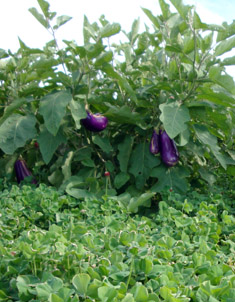Serving Up a Bitter End for Eggplant Pests
 |
|
Guardians of deliciousness: Crimson clover interplanted among eggplant protects it from flea beetle and Colorado potato beetle. Source: C. Hooks, University of Maryland |
Scientists discover an environmentally-friendly recipe for unwelcome eggplant guests.
Whether smothered under melted mozzarella alla Parmigiana or spread on pita as a tongue-tantalizing baba ghanoush, Northeasterners love eggplant. Consumers in the Northeast purchase eggplant 28 percent more often than those in any other US region. But, you may have noticed that farm stands are lacking their usual bounty of the shiny purple nightshade. The culprits? Flea beetle and Colorado potato beetle (CPB). With a grant from the Northeastern IPM Center, Cerruti Hooks (University of Maryland) and his team have found a practical, organic, and cost-effective way to prevent infestations of these eggplant pests.
The tiny flea beetle makes pinhole-sized feeding “shot holes” in the leaves and plant of seedling eggplants, stunting their growth and often killing them altogether. CPB, known for its ability to develop resistance to insecticides, can overwhelm a crop and defoliate the plant. CPB employs a reproductive strategy entomologists call bet-hedging—distributing its offspring in different places and at different times, diminishing the effectiveness of traditional pesticides and crop rotations.
Many northeastern growers are interested in solutions that reduce the use of synthetic pesticides while preventing crop loss from pests. Organic growers nationwide also have been hoping for an answer. In response to grower needs, Hooks and his team implemented the strategy of using crimson clover as a cover crop that would help reduce eggplant pest infestations.
Crimson clover, over and over.
Why crimson clover? “Crimson clover contained all the cover crop superhero characteristics,” said Hooks. As a nitrogen fixer, crimson clover converts atmospheric nitrogen into compounds that growing eggplant plants need. As a winter cover crop, crimson clover naturally senesces during the spring and does not compete with eggplant; crimson clover attracts beneficial insects and increases the soil’s organic matter. Furthermore, it suppresses early season weeds while decreasing soil erosion and surface water pollution.
“We were surprised by how well interplanting the eggplant into crimson clover slowed the colonization of eggplant by CPB,” Hooks said. “We didn’t realize it would delay their early-season colonization to such an extent.”
Hooks says his most exciting finding came when his team discovered that planting eggplant into crimson clover cover crops works as well as weekly organic insecticide applications against CPB infestations. “Eggplant in the crimson clover plots did not benefit from insecticide applications,” said Hooks. His team observed similar CPB numbers in sprayed and unsprayed crimson clover subplots, showing that crimson clover, as a cover crop, works as effectively as routine organic pesticide applications in this setting.
Delicious future for eggplant lovers?
Hooks believes that more studies are necessary in the near future. The unanticipated emergence of the brown marmorated stink bug (BMSB) as an eggplant pest, for example, calls for more field research on eggplant pests.
Growers can reduce pest damage by avoiding planting eggplant crops in high-risk areas such as potato fields. Hooks offers an extra piece of advice for warding off BMSB: avoid planting eggplant near BMSB overwintering sites, such as near barns and woodlots. If eggplant growers adopt the recipe for success suggested by this team’s research, eggplant lovers can expect to see more eggplant in their markets and farm stands, knowing organic and IPM methods have reduced potential pesticide risks and costs.
For more information: “Impact of crimson clover dying mulch on two eggplant insect herbivores” Journal of Applied Entomology (May 2, 2012).
— by LIANE WORTHINGTON
The Northeastern IPM Center promotes integrated pest management for reducing risks to human health and the environment. If republishing our news, please acknowledge the source (“From Northeast IPM Insights”) along with a link to our website.
